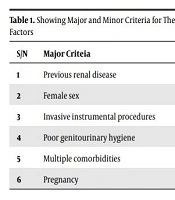1. Background
Urinary tract infections (UTI) simply the symptomatic or asymptomatic colonization of the kidneys, ureters, urinary bladders or/and the urethra by microorganisms, commonly bacteria (1, 2). When these infections affect the kidneys, it is known as pyelonephritis (3).
Although UTIs may be as a result of ascending or haematogenous route of infection, the Ascending route is the most common infection pathway (3). This is because our bodies are exposed continually to bacteria, viruses, fungi, and parasites, all of which occur normally and to varying degrees in the lining of the urinary tract but, are localized to the lower path of the urinary tract in healthy individuals (2, 4).
Furthermore, the clinical spectrum of presentations of urinary tract infection is an asymptomatic bacteriuria, symptomatic acute urethritis and cystitis before acute pyelonephritis (2). This evidently shows an ascending pathology.
However, one of the most troubling hematogenously spread UTI is renal tuberculosis. It is classically a secondary tuberculosis infection. These patients characteristically often have sterile pyuria. Although it is treatable; presentation and diagnosis are often made late (2, 4, 5). Renal tuberculosis is not the only granulomatous UTI, xanthogranulomatous UTI is similar. However, it is differentiated from renal tuberculosis by presence of lipid laden cells, known as foam cells (6).
Personal hygiene is a critical attribute in the prevention of UTIs, starting from limiting nephrotoxic substances intake, to regular clean underwear changing to usage of clean and properly maintained toilet facilities. In Nigeria, only 56% of Nigerian households use an improved sanitation facility. The proportion of households with no toilet facility has decreased over the last 5 years, from 29% of households in 2013 to 25% of households in 2018 (7, 8).
Although bacteria and fungi are more likely to cause UTI, Viral UTI is uncommon but should be considered as a potential diagnosis in immunocompromised hosts (9).
2. Objectives
The aim of this study is to calculate the percentile risk of medically inclined apparently healthy individuals acquiring urinary tract infections.
Some risk factors of UTI are listed below (1-3, 10, 11);
1- Age (infants, older patients > 60 years)
2- Anatomic abnormality (vesicoureteral reflux, polycystic kidney disease, horseshoe kidney, double ureter, ureterocele)
3- Foreign body (renal stone, urinary, ureteric, or nephrostomy catheter)
4- Impaired renal function
5- Immunocompromised (diabetes mellitus, sickle cell disease, transplantation, malignancy, chemotherapy, radiotherapy, alcohol dependence, human immunodeficiency virus (HIV), corticosteroid use or use of immunosuppressant)
6- Instrumentation (cystoscopy)
7- Male sex (recurrent infection, infection foci in prostate, anatomic abnormalities)
8- Female sex (short urethra, sexual intercourse, closeness to anal canal, absence of acidic prostatic
secretions, etc.)
9- Obstruction (benign prostatic hypertrophy, renal stone, foreign body, bladder neck obstruction, 40 posterior ureteral valve or neurogenic bladder
10- Pregnancy
3. Methods
Written consent was sought on every questionnaire. It was carried out within the period of August to November, 2018.
As regards the sample size, 40 questionnaires were sent to each of the 5 facilities. This is roughly estimated to be 10% of people amongst the hospitals staff and 20% of those in health colleges. Of these, only 160 questionnaires were filled, and 154 accepted as properly filled (males, N = 71 with an age range of 19 - 45 years; females, N = 83 with an age range of 19 - 44 years).
The study population was chosen from amongst medically inclined individuals to meet the aim of this study. The questionnaires were gender specific. Persons cut across doctors, nurses, laboratory scientists, Nursing Students and medical students. The sampling study used was single blinded method. Areas studied were Plateau state (Jos University Teaching Hospital, Plateau Specialist Hospital and school of Midwifery; Vom), Abuja (University of Abuja Medical College Campus) and Nasarawa state (Bingham University). Data was collected, tabulated and classified into mild, moderate and high risks.
3.1. Classification Criteria
Abuse and overdose of acetaminophens remains a minor criterion as regards analgesic nephropathy. Whilst the presence of diabetes mellitus and/or Sickle cell disease remains significant criteria in both sexes.
3.2. Inclusion Criteria
(a) Absence of any major criteria- minor risk or UTI, (b) relatively, presence of one Major criteria- moderate risk of UTI, and (c) presence of two or more major criteria- high risk of UTI (based on the criteria listed in Tables 1 and 2).
| S/N | Major Criteia | Minor Criteria |
|---|---|---|
| 1 | Previous renal disease | Sex |
| 2 | Female sex | Drugs and chemotherapy |
| 3 | Invasive instrumental procedures | Family Hx of UTI or DM |
| 4 | Poor genitourinary hygiene | Ignorance |
| 5 | Multiple comorbidities | Anatomic abnormality |
| 6 | Pregnancy | Withholding urination |
Showing Major and Minor Criteria for The Classification of Female UTI Risk Factors
| S/N | Major Criteria | Minor Criteria |
|---|---|---|
| 1 | Previous renal disease | Sex |
| 2 | Sexually transmissible infections | Drugs and chemotherapy |
| 3 | Invasive instrumental procedures | Family Hx of UTI or DM |
| 4 | Poor genitourinary hygiene | Ignorance |
| 5 | Multiple comorbidities | Anatomic abnormality |
| 6 | Urinary tract obstruction | Withholding urination |
Showing Major and Minor Criteria for the Classification of Male UTI Risk Factors
4. Results
Table 3 shows the difference in risk prevalence between the male and female health workers. While male health workers have more of low risks, female health workers have more than 6 times risks of coming down with a UTI, which may be symptomatic or non-symptomatic.
| Assessment Criteria | Male, No. (%) | Female, No. (%) |
|---|---|---|
| Low risk | 42 (59.2) | 10 (12.0) |
| Moderate risk | 23 (32.4) | 29 (34.9) |
| High risk | 6 (08.5) | 44 (53.0) |
Tabulated Result Showing the Percentage of Low, Moderate and High Risks in Medically Inclined Individuals
5. Discussion
The study took into considerations questions factors that were gender specific and could lead to urinary tract infections. It also asked questions on some predisposing areas that could act as a pathway to the pathophysiology of urinary tract infection.
The males were not at as much risk of acquiring Urinary Tract infection as the females. Most men that still complained of lower abdominal pains and flank pains had a history of pyelonephritis, cystitis or/andurethritis.
A special case was seen of a sickle cell patient. He had a history of cystitis and pyelonephritis. Often had ureteric colic, commonly associated with calculi, although may be seen in blood clots (2). As at the time of filling the questionnaire, he had flank tenderness, but had neither fever nor lower urinary tract symptoms. We were not able to ask him further questions concerning his presentation, to rule in or rule our SCD nephropathy because, the study was single blinded. Blinded to Us.
Among the females major predisposing factors like infrequent changes of sanitary pads, underwear and sex were also asked on. Just like in the case of the men, some who had a history of cystitis or pyelonephritis still complained of flank pains and lower abdominal pains.
The absence of knowledge can be fatal (Hosea 4:6). Hence, the fact that some people were completely ignorant of UTIs, risk factors and how to prevent them was also taken into serious account. For you cannot avoid the stone you don’t see coming. Hence, ignorance in itself was considered a predisposing factor.
Other medical conditions such as Diabetes mellitus that could lead to nephropathy or complicate an already existing pyelonephritis were asked about. However, due to the age ranges study subjects, risks of chronic nephrogenic pathologies were minimal. The males studied had no history of benign prostatic hyperplasia (BPH).
The treatment of UTI is a multidisciplinary task and should be handled as such. As improper or lack of appropriate treatments can lead to complications such as scarring, septicemia or chronic pyelonephritis (3, 4).
Although UTI is a common presentation to medical consultations, it is often not given sufficient attention by most Nigerians until it becomes symptomatically uncomfortable. This should not be so, because the long term pathologies of UTI cause some serious morbidity not just in the renal system but also circulatory. For example, studies have shown that UTI will predispose people to development of hypertension in the future (2, 3, 12, 13).
5.1. Conclusion
Hygiene is a crucial factor in predisposition to UTI. Women are at higher risk of acquiring urinary tract infections. Sickle cell may be a predisposing factor to pyelonephritis.

